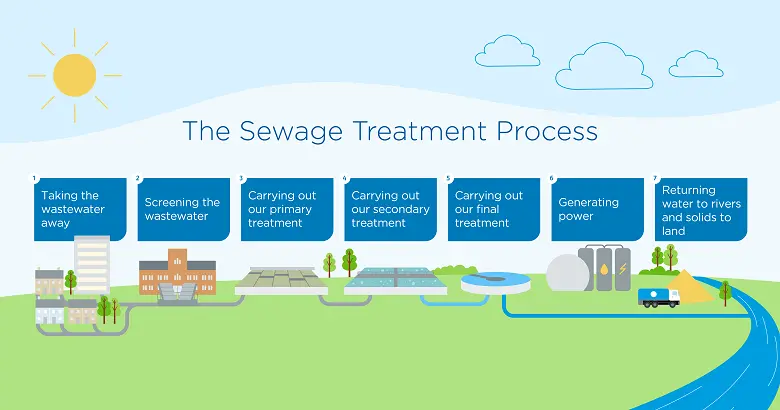The sewage treatment process
As well as delivering safe, clean and reliable water to you, we also need to take it away once you’ve used it. When you empty the bath, flush the toilet or use your washing machine, it’s our job to make sure that all that used water – what we call wastewater – is treated and returned safely into rivers.
In some areas, including central London, surface water and sewage mix together before being treated at our sewage works.
Did you know?
We manage over 68,000 miles of sewers, 5,235 pumping stations and 1.48 million manholes across our region.

1. Taking the wastewater away
Whenever you flush the toilet or empty the sink, the wastewater goes down the drain and into a pipe, which takes it to a larger sewer pipe under the road. The sewer then joins our network of other sewers and takes the wastewater to a sewage treatment works.
At the sewage works, we pass the wastewater through several cleaning and filtering processes so that we can return it safely into rivers.
Did you know?
In London, our team of sewer flushers regularly inspect the large Victorian sewers to help keep our capital’s waste moving.
2. Screening the wastewater
First, we remove large objects that may block or damage equipment or pollute our rivers. This includes items that should never have been put down the drain in the first place, such as nappies, wet wipes, sanitary items and cotton buds, and sometimes even things like bricks, bottles and rags.
We then use special equipment to filter out grit, as this often washes into the sewer with wastewater.
Did you know?
Every year, people putting the wrong things down the drain causes over 65,000 blockages, which flood thousands of homes and gardens. That’s why we say bin it – don’t block it.
3. Carrying out primary treatment
Wastewater still contains organic solid matter – otherwise known as human waste. We separate the waste from the water by putting it into large settlement tanks, where solids sink to the bottom. We call the settled solids ‘sludge’. Large arms or scrapers help to push the sludge towards the centre, where it’s then pumped away for further treatment.
The cleaner water passes over a wall near the top of the tank ready for the next stage of the treatment process.
Did you know?
We use sludge to generate renewable energy, which powers our sites. In 2019 we self-generated over 23% of our electricity needs, the equivalent of £37 million in electricity.
4. Secondary treatment
Although we’ve removed the visible bits of sludge, we need to take out some of the smaller and sometimes invisible organisms as well.
At our larger sewage treatment works, we put the wastewater into rectangular tanks called ‘aeration lanes’, which pump air into the water. This encourages the useful bacteria to break down and eat the harmful bacteria. The more the useful bacteria eat, the more they grow and multiply, until all the nasty bugs have gone.
Did you know?
At over 350 sewage treatment works, we treat 4,600 million litres of sewage from our 16 million customers, every single day.
5. Carrying out final treatment
We pass the treated wastewater through a final settlement tank, where the useful bacteria sink to the bottom. This forms more sludge, which we recycle back to the secondary treatment stage.
The clean water then passes over a wall near the top of the tank.
At this point, we may need to carry out one additional treatment – filtering the water slowly through a bed of sand, which catches any remaining particles.
6. Generating power
We treat the sludge we collect at the start of the process so that we can put it to good use. We recycle most of it to agricultural land for farmers to use as fertiliser, but we also use it to generate energy. We do this in several different ways:
- Combined heat and power: We treat the sludge using a process called ‘anaerobic digestion’. This heats the sludge up to high temperatures, encouraging the bacteria inside to break down the waste. This creates biogas that we can then burn to create heat, which in turn creates electricity.
- Thermal destruction: We dry the sludge into blocks called ‘cake’, which are then burned to generate heat. We capture this heat and turn it into electricity.
Did you know?
We’ve been generating electricity from waste for more than 50 years.
7. Returning water to the river and solids to land.
Once the wastewater is clean, we can return it safely to local rivers and streams. Putting clean water back into the river is very important, as it helps to keep water flowing and wildlife thriving.
The Environment Agency strictly regulates the quality of the cleaned wastewater, and we test it to make sure that it meets their high-quality standards.
The ‘sludge cake’ which remains after the energy production is put to good use. We recycle it to agricultural land for farmers to use as fertiliser.